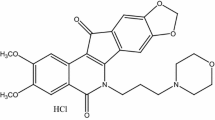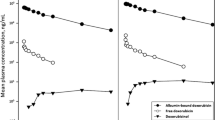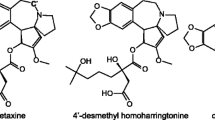Abstract
DACA {N-[2-(dimethylamino)ethyl]acridine-4-carboxamide} is an acridine derivative with high activity against solid tumours in mice and a dual mode of cytotoxic action involving topoisomerases I and II. The plasma pharmacokinetics of DACA were studied in 28 patients with solid tumours in a phase I trial. A single dose was given every 3 weeks, being escalated from a starting dose of 18 mg/m2 (as the dihydrochloride trihydrate salt) to a maximal dose, limited by severe pain in the infusion arm, of 1000 mg/m2. Drug was given by constant intravenous infusion with a target delivery period of 3 h. Blood samples were taken from the contralateral arm before, during and for up to 72 h after the infusion. DACA was separated from plasma by solid-phase extraction and was analysed by reversed-phase high-performance liquid chromatography (C18 column) using fluorescence detection. A two-compartment pharmacokinetic model provided the best fit for the concentration-time profiles obtained for most patients showing clearance of 1.00 ± 0.36 l h−1 kg−1, a volume of distribution of the central compartment of 0.72 ± 0.55 l/kg, an initial half-life of 0.28 ± 0.19 h and a terminal half-life of 2.04 ± 0.94 h. All pharmacokinetic parameters were independent of dose, indicating first-order kinetics. As DACA binds strongly to α1-acid glycoprotein, plasma concentrations of this protein were determined and used to estimate free-drug fractions in plasma. Estimated values for the free fraction varied from 0.9% to 3.3% and were lower than those determined by equilibrium dialysis for mice and rats (15% and 16%, respectively). At the maximum tolerated dose (MTD) of 750 mg/m2, the area under the drug concentration-time curve (AUC) was 46.2 ± 4.4 μM h, exceeding that obtained in mice treated at the MTD (23.4 μM h). On the other hand, the corresponding free-drug AUC was 0.92 ± 0.03 μM h, much lower than the corresponding value (3.5 μM h) determined for mice. These results suggest that free-drug rather than total drug concentrations are more appropriate for interspecies dose comparisons when significant differences exist in the free plasma fraction.
Similar content being viewed by others
Author information
Authors and Affiliations
Additional information
Received: 27 August 1998 / Accepted: 10 December 1998
Rights and permissions
About this article
Cite this article
Kestell, P., Dunlop, I., McCrystal, M. et al. Plasma pharmacokinetics of N -[2-(dimethylamino)ethyl]acridine-4-carboxamide in a phase I trial. Cancer Chemother Pharmacol 44, 45–50 (1999). https://doi.org/10.1007/s002800050943
Issue Date:
DOI: https://doi.org/10.1007/s002800050943




